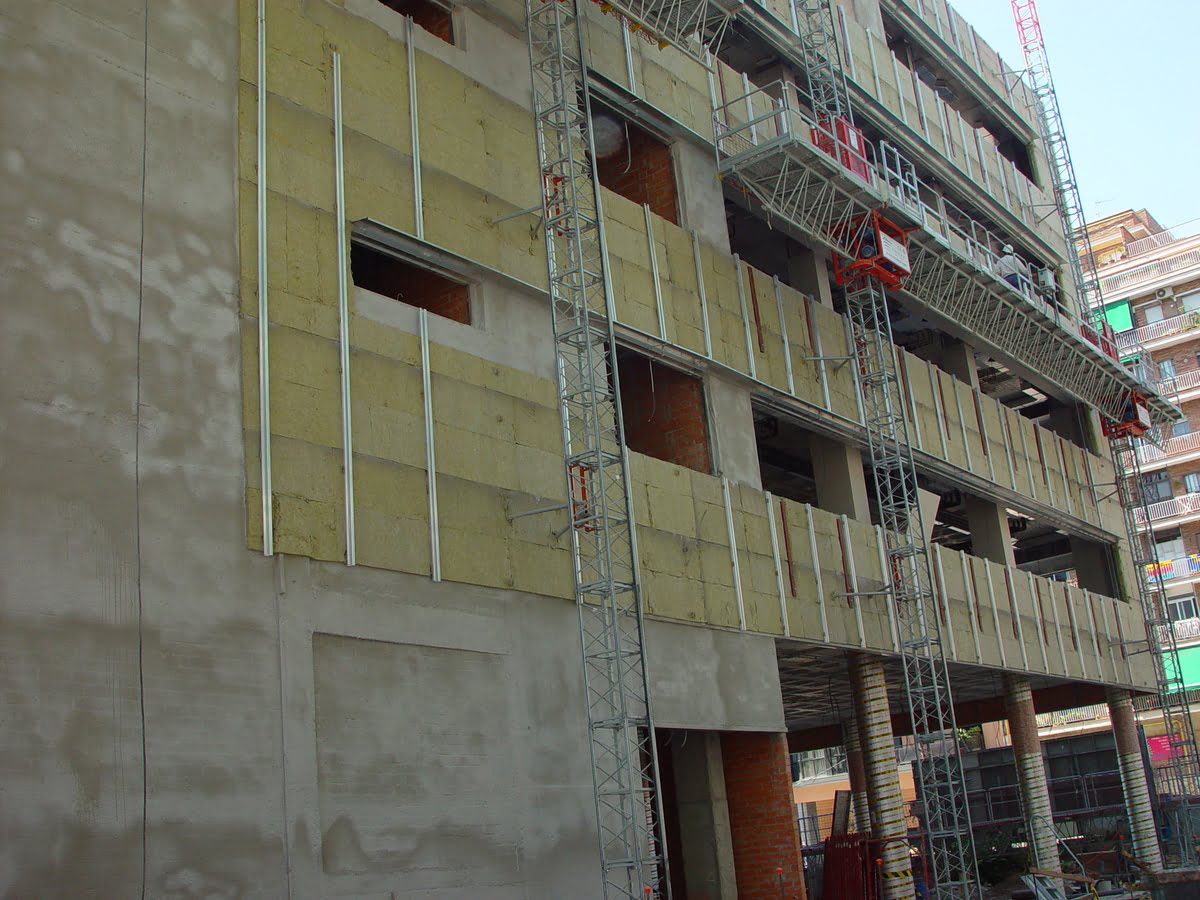Home>diy>Building & Construction>What Does “NTP” Mean In Construction


Building & Construction
What Does “NTP” Mean In Construction
Modified: December 7, 2023
Learn the meaning of "NTP" in building construction. Discover how it plays a crucial role in project timelines and ensuring successful completion.
(Many of the links in this article redirect to a specific reviewed product. Your purchase of these products through affiliate links helps to generate commission for Storables.com, at no extra cost. Learn more)
Introduction
In the world of construction, there are many acronyms and terms that can often be confusing for those not familiar with the industry. One such term is “NTP,” which stands for Notice to Proceed. But what exactly does this mean in the context of construction projects? In this article, we will delve into the definition and importance of NTP in construction, as well as explore the NTP documents and process, legal implications, and its role in construction scheduling and project management.
At its core, the Notice to Proceed (NTP) is a crucial document that marks the official starting point of a construction project. It is typically issued by the project owner or the general contractor to the selected contractor or subcontractor, granting them permission to begin the construction activities as outlined in the contract.
The NTP serves as a formal notification to the contractor that they can mobilize their resources, start procuring materials, and commence the work on the project site. It is a milestone moment that signifies the project is transitioning from the planning and preparation phase to the execution phase.
Receiving the NTP is typically a significant moment for construction companies, as it signifies that they have successfully won the contract and are now authorized to move forward with the project. It is a moment of validation for all the hard work put into the bidding process and showcases the trust and confidence placed in the contractor’s abilities.
Next, let’s delve into the importance of NTP in construction projects and why it plays a crucial role in project execution.
Key Takeaways:
- NTP, or Notice to Proceed, is a crucial document in construction, marking the official start of a project and setting the stage for successful execution by providing legal authorization, clear timelines, and effective communication.
- Leveraging NTP in construction projects offers benefits such as efficient resource planning, improved scheduling, risk mitigation, legal protection, effective communication, accountability, and enhanced client confidence, ultimately contributing to successful project delivery.
Definition of NTP
In the context of construction, the Notice to Proceed (NTP) is a legal document that formally authorizes the selected contractor or subcontractor to commence work on a construction project. It serves as a directive from the project owner or general contractor to the contractor, indicating that they can move forward with the project according to the agreed-upon terms and conditions.
The NTP contains essential information such as the project start date, project specifications, scope of work, and any specific requirements or conditions that the contractor needs to adhere to. It outlines the timeline for completing various construction phases, milestones, and deliverables.
By issuing the NTP, the project owner or general contractor communicates their acceptance of the contractor’s bid and signifies their intent to proceed with the project. This document serves as a legally binding agreement between the parties involved and lays the foundation for the contractual obligations and responsibilities of both the owner and the contractor.
The NTP establishes a clear and definitive starting point for the construction project. It ensures that all parties are aligned and aware of their roles and responsibilities from the beginning. Following the issuance of the NTP, the contractor can mobilize their resources, procure necessary materials, hire subcontractors if needed, and begin the construction activities as outlined in the contract.
It is essential to note that the NTP typically includes a timeframe within which the contractor must commence work. This is done to ensure that the project progresses in a timely manner and avoids unnecessary delays.
The NTP not only provides authority and permission for the contractor to start the construction work but also establishes the terms under which the project will be executed. It sets the stage for a clear understanding between the parties involved, managing expectations and facilitating effective communication throughout the construction process.
Now that we have a clear definition of NTP, let’s explore its importance in construction projects.
Importance of NTP in Construction Projects
The Notice to Proceed (NTP) holds immense significance in construction projects. It serves as a critical milestone and sets the stage for the successful execution of the project. Here are some key reasons why NTP is vital in construction:
- Clarity and Authorization: The NTP provides legal and contractual authorization to the contractor or subcontractor to commence work on the project. It eliminates any ambiguity and ensures that all parties are on the same page regarding the project’s initiation.
- Commencement Date: The NTP specifies the project’s start date, enabling the contractor to plan their resources accordingly. This clarity helps avoid any confusion and ensures a smooth transition from the pre-construction phase to the construction phase.
- Resource Mobilization: With the NTP in hand, contractors can mobilize their resources effectively. They can begin procuring materials, deploying equipment, hiring workers, and scheduling subcontractors, all based on the project’s authorized start date.
- Scheduling and Coordination: The NTP forms the basis for construction scheduling and coordination. It outlines the timeline for completing various project milestones and deliverables, allowing contractors to plan their activities and allocate resources efficiently.
- Risk Management: The NTP plays a crucial role in managing risks associated with construction projects. It ensures that work commences only after necessary permits, licenses, and insurance requirements are in place. This mitigates potential legal and financial risks for both the owner and the contractor.
- Contractual Obligations: The NTP establishes the contractual obligations and responsibilities of both the owner and the contractor. It forms the basis for the construction contract and sets the terms under which the project will be executed, including the scope of work, specifications, and project deliverables.
- Accountability and Payments: The NTP defines the milestones and deadlines for project completion, ensuring that both parties are accountable for meeting these targets. It supports the payment process by linking progress payments to completed work stages as defined in the NTP.
Overall, the NTP serves as a critical foundation for successful project execution. It eliminates uncertainties, establishes clear expectations, and facilitates effective communication between the owner and the contractor. By providing authorization, clarity, and direction, the NTP sets the project on the right path from the very beginning.
Now that we understand the importance of NTP in construction, let’s explore the NTP documents and the process involved.
NTP Documents and Process
The issuance of the Notice to Proceed (NTP) involves a specific set of documents and a well-defined process. Let’s explore the NTP documents and the typical steps involved:
NTP Documents:
- Contract Agreement: The contract agreement is the primary document that outlines the terms and conditions of the construction project. It includes details such as project scope, specifications, timelines, and payment terms. The NTP is typically a part of the contract agreement.
- Letter of Intent (LOI): In some cases, a Letter of Intent is issued before the NTP. The LOI expresses the intention of the owner or general contractor to award the contract to the selected contractor. It sets the stage for the NTP issuance and may provide instructions for further actions.
- Construction Schedule: The construction schedule is a document that outlines the planned timeline for different project phases, milestones, and deliverables. It helps in coordinating construction activities and aligning them with the NTP.
- Contractor’s Acceptance: The contractor typically needs to formally acknowledge and accept the NTP. This could be done through a written acceptance letter or by signing and returning a copy of the NTP to the owner or general contractor.
NTP Process:
- Contract Award: The process begins with the award of the construction contract to the selected contractor. This is usually based on a competitive bidding process, where the contractor’s proposal is evaluated and chosen as the most suitable option.
- Pre-NTP Preparation: Before issuing the NTP, the project owner or general contractor needs to have all necessary documents and requirements in place. This includes finalizing the contract agreement, ensuring appropriate permits and licenses, and confirming financial arrangements.
- Issuance of NTP: Once all preparations are complete, the owner or general contractor issues the NTP to the selected contractor. The NTP outlines the project start date, project specifications, and any specific requirements or conditions the contractor needs to adhere to.
- Contractor’s Acceptance: Upon receiving the NTP, the contractor acknowledges and accepts the NTP either in writing or by signing and returning a copy to the owner or general contractor. This confirms their commitment to start work as per the outlined terms.
- Project Mobilization: With the NTP accepted, the contractor can mobilize their resources, procure materials, set up construction equipment, and begin site preparations. They can also start coordinating with subcontractors and suppliers to ensure a smooth start to the project.
- Construction Activities: Once the NTP is issued and mobilization is complete, the contractor begins the construction activities as defined in the contract. They follow the project schedule, coordinate with stakeholders, and work towards achieving the project milestones and deliverables.
The NTP documents and process provide the necessary framework for a smooth and organized transition from contract award to project execution. They ensure that all parties are aligned and understand their roles and responsibilities, promoting effective coordination and successful project delivery.
Now that we have explored the NTP documents and process, let’s discuss the legal implications of NTP in construction projects.
Legal Implications of NTP
The Notice to Proceed (NTP) holds significant legal implications for both the project owner or general contractor and the contractor or subcontractor. It establishes the contractual relationship and obligations between the parties involved. Let’s explore the legal aspects associated with NTP in construction projects:
Contractual Agreement:
The NTP is a critical component of the construction contract. It sets forth the terms and conditions under which the project will be executed. By accepting the NTP, the contractor agrees to abide by these contractual obligations, including project specifications, timelines, and payment terms. Failure to comply with the terms outlined in the NTP can result in legal consequences, such as breach of contract claims or disputes.
Project Scope and Changes:
The NTP provides clarity on the project scope, including the defined deliverables and specifications. Any changes or modifications to the project scope after the issuance of the NTP may require formal change orders or amendments to the contract. It is essential for both parties to properly document and approve any changes to avoid disputes or disagreements later on.
Contractor’s Performance:
The NTP sets the expectations for the contractor’s performance. It establishes the timeline for completing various project milestones and deliverables, establishing benchmarks for assessing the contractor’s progress. In the event of delays or subpar performance, the NTP can be referenced to determine if the contractor is adhering to the agreed-upon terms. Non-performance or significant deviations from the NTP can result in legal claims or termination of the contract.
Payment and Disputes:
The NTP defines the payment terms and conditions, including milestone payments and the final payment upon project completion. Disputes related to payment can arise if there is a disagreement about the work completed or the quality of work. In such cases, the NTP can serve as a basis for resolving payment disputes through mediation, arbitration, or legal proceedings.
Liability and Insurance:
By accepting the NTP, the contractor assumes certain liabilities associated with the construction project. The NTP may outline the required insurance coverage that the contractor must maintain during the project. Failure to maintain the necessary insurance or fulfill liability obligations can result in legal consequences and financial repercussions for the contractor.
Performance Bonds and Surety:
Depending on the project scale and contractual requirements, the NTP may require the contractor to provide performance bonds or surety bonds. These bonds serve as a guarantee that the contractor will fulfill their obligations under the contract. In the event of non-performance or default, the owner or general contractor may make a claim against the performance bond to recover damages or complete the project.
It is crucial for both the owner or general contractor and the contractor to carefully review and understand the legal implications associated with the NTP. Consulting legal counsel or construction professionals can help ensure the NTP is comprehensive, adequately addresses legal aspects, and protects the rights and interests of all parties involved.
Now that we have explored the legal implications of NTP, let’s dive into its role in construction scheduling.
NTP stands for “Notice to Proceed” in construction. It is a formal written notice from the client to the contractor authorizing the start of work on a project.
Read more: What Does “CO” Mean In Construction
NTP in Construction Scheduling
The Notice to Proceed (NTP) plays a vital role in construction scheduling. It serves as a key milestone that marks the official start of the construction project and sets the timeline for completing various activities and milestones. Here’s how the NTP influences construction scheduling:
Project Start Date:
The NTP specifies the project start date, providing a definitive point from which the construction activities can begin. It allows the contractor to plan and allocate resources accordingly, ensuring that the project starts on schedule. The project start date outlined in the NTP forms the basis for developing a comprehensive construction schedule.
Activity Sequencing:
Once the NTP is issued, the contractor can use it as a reference to identify and sequence the various activities required to complete the project. The NTP allows for a logical progression of tasks and ensures that the right activities are scheduled at the right time. It helps the contractor determine which tasks can be initiated immediately and which ones are dependent on the completion of preceding activities.
Milestones and Deliverables:
The NTP serves as a guide for establishing project milestones and deliverables. By referring to the NTP, the contractor can define and schedule critical points in the construction process, such as foundation work, completion of structural elements, installation of utilities, and project handover. These milestones are essential for tracking progress and ensuring timely completion of the project.
Timeline Management:
The NTP provides the framework for managing the project timeline. It outlines the duration of the construction project and assists in developing a realistic and achievable construction schedule. By following the timeline specified in the NTP, the contractor can monitor and manage project progress, identify potential delays, and take proactive measures to stay on schedule.
Coordination of Activities:
The NTP helps in coordinating various construction activities. It ensures that subcontractors, suppliers, and other stakeholders are aligned with the project timeline and aware of their respective roles and responsibilities. The NTP acts as a reference point for coordinating deliveries, subcontractor timelines, and scheduling inspections or approvals, enabling efficient collaboration among all involved parties.
Integration with Other Schedules:
The NTP is integrated with other schedules, such as procurement schedules, equipment mobilization schedules, and workforce scheduling. It provides the start date for these activities and helps in synchronizing them with the overall construction schedule. By aligning these schedules with the NTP, the contractor can ensure a seamless flow of work and eliminate potential bottlenecks.
It is important to note that construction scheduling is an ongoing process that requires regular monitoring and adjustments. The NTP serves as the initial foundation for scheduling and acts as a reference point throughout the construction project. Any changes to the project scope, timeline, or other factors should be properly documented and communicated to all relevant stakeholders to facilitate accurate and effective scheduling adjustments.
Now that we understand the role of NTP in construction scheduling, let’s delve into its significance in project management.
NTP in Project Management
The Notice to Proceed (NTP) plays a crucial role in project management within the construction industry. It serves as a fundamental element in coordinating and overseeing the successful execution of construction projects. Let’s explore the significance of NTP in project management:
Initiating the Project:
The NTP marks the official initiation of the project and sets the project in motion. It provides a clear starting point for project managers to mobilize resources, engage stakeholders, and begin executing the project plan. By having a defined start date, project managers can effectively organize and manage the project from the very beginning.
Establishing Project Milestones:
The NTP forms the basis for establishing project milestones, which are significant events or achievements within the project timeline. These milestones serve as markers for progress evaluation and control. By aligning project milestones with the NTP, project managers can monitor the project’s progress and ensure that important deliverables are completed within the specified timeframe.
Monitoring and Controlling Progress:
The NTP provides project managers with a reference point to monitor and control the project’s progress. It assists in tracking the project’s timeline against the established schedule, allowing project managers to identify any delays or deviations and take immediate corrective actions. By closely monitoring progress, project managers can mitigate risks, manage resources effectively, and ensure the project remains on track.
Managing Resources:
The NTP acts as a guide for allocating and managing project resources. It enables project managers to plan the deployment of manpower, equipment, materials, and subcontractors based on the project start date specified in the NTP. This resource management ensures optimal utilization, helps in avoiding resource shortages, and supports the seamless execution of project activities.
Communication and Stakeholder Engagement:
The NTP serves as a critical communication tool for project managers to engage and inform stakeholders about the project’s commencement. It provides a common understanding and expectations of project timelines, deliverables, and milestones. Project managers can leverage the NTP to communicate project updates, progress, and any changes that may impact stakeholders. Effective communication enhances collaboration, minimizes misunderstandings, and fosters a positive working relationship with stakeholders throughout the project lifecycle.
Risk Management:
The NTP plays a crucial role in risk management within project management. It allows project managers to identify potential risks that may impact project timelines and implement necessary mitigation strategies. By aligning risk management efforts with the NTP, project managers can proactively address risks, such as delays in receiving necessary permits or disruptions in the supply chain, and minimize their impact on the project’s overall success.
Overall, the NTP serves as a vital tool for project managers in the construction industry. It initiates the project, sets project milestones, helps in monitoring progress, facilitates resource management, strengthens communication, and assists in effective risk management. By leveraging the NTP within project management practices, project managers can enhance project performance, ensure timely completion, and deliver successful construction projects.
Now that we have explored the role of NTP in project management, let’s discuss the benefits of utilizing NTP in construction projects.
Benefits of Using NTP
Utilizing the Notice to Proceed (NTP) in construction projects offers several benefits that contribute to a smooth and successful project execution. Here are some key advantages of using NTP:
Clear Project Initiation:
The NTP provides a clear and official start date for the construction project. This clarity ensures that all stakeholders are on the same page and aware of when work is scheduled to commence. It eliminates any confusion or ambiguity and sets the project on a solid foundation from the start.
Efficient Resource Planning:
The NTP allows contractors to plan and allocate their resources effectively. With a defined project start date, contractors can mobilize their workforce, procure materials, and schedule subcontractors in a timely manner. This efficient resource planning leads to cost savings, streamlined operations, and optimized utilization of resources.
Improved Scheduling and Coordination:
By providing a clear timeline for project milestones and deliverables, the NTP facilitates better scheduling and coordination. Contractors can align their activities, manage dependencies, and ensure a smooth flow of work. This synchronized approach minimizes conflicts and delays, resulting in efficient project execution.
Risk Mitigation:
The NTP helps identify and address potential risks early on in the project. By establishing a clear timeline, contractors can assess and plan for potential project risks, such as permit delays or supply chain disruptions. This proactive risk management strategy prevents or mitigates potential project delays and cost overruns.
Legal Protection:
The NTP serves as a contractual document that protects the rights and obligations of both the owner and the contractor. It establishes the terms and conditions under which the project will be executed, minimizing the risk of disputes or disagreements. In the event of any contractual disputes, the NTP becomes a vital reference point for resolving issues.
Effective Communication:
The NTP serves as a communication tool, ensuring that all stakeholders have a clear understanding of project timelines and expectations. Contractors can effectively communicate the project start date to their team, subcontractors, and suppliers. This streamlined communication promotes collaboration, reduces misunderstandings, and supports a harmonious working relationship.
Accountability and Progress Tracking:
The NTP establishes project milestones and deliverables, allowing for effective progress tracking and accountability. Contractors can monitor and measure their progress against the agreed-upon timeline, ensuring that the project stays on schedule. This accountability fosters transparency, enhances project control, and facilitates timely delivery of project milestones.
Client Confidence:
The NTP provides clients with confidence in the contractor’s ability to deliver the project successfully. By issuing the NTP, clients acknowledge their trust in the contractor and their capabilities. This confidence strengthens the working relationship between the client and the contractor, leading to future opportunities and positive references.
Overall, utilizing the Notice to Proceed (NTP) in construction projects brings numerous benefits. It ensures clear project initiation, supports efficient resource planning, improves scheduling and coordination, mitigates risks, provides legal protection, facilitates effective communication, promotes accountability, and enhances client confidence. By leveraging the NTP effectively, construction projects are set up for success and have a better chance of being completed on time and within budget.
Now let’s conclude our discussion on the importance of NTP in construction projects.
Conclusion
The Notice to Proceed (NTP) plays a pivotal role in construction projects, serving as the official authorization to commence work. It sets the project in motion, establishes project milestones, and enables effective project management. Throughout this article, we have explored the definition, importance, and various aspects of NTP in construction.
From a legal standpoint, the NTP defines the contractual relationship between the project owner or general contractor and the contractor or subcontractor. It outlines the project scope, terms, and obligations, ensuring clarity and minimizing potential disputes. The NTP also carries significant scheduling implications, aligning activities, and providing a timeline for project completion.
The benefits of using NTP are numerous. It initiates the project on a clear and organized footing, allowing for efficient resource planning, improved scheduling, and effective risk mitigation. It also facilitates clear communication among stakeholders, fosters accountability, and enhances client confidence in the contractor’s abilities.
It is important for construction professionals to understand the NTP process, the associated legal implications, and its role in project management. By leveraging the NTP effectively, construction projects can be executed in a timely manner, ensure optimal resource utilization, and minimize delays and disputes.
In conclusion, the Notice to Proceed (NTP) is a crucial document in construction projects, marking the official start and setting the framework for successful project execution. By utilizing the NTP, construction companies can facilitate effective project management, ensure compliance with contractual obligations, and deliver projects that meet stakeholders’ expectations.
So, next time you come across the term “NTP” in construction, remember its significance and the impact it has on the successful completion of construction projects.
Frequently Asked Questions about What Does "NTP" Mean In Construction
Was this page helpful?
At Storables.com, we guarantee accurate and reliable information. Our content, validated by Expert Board Contributors, is crafted following stringent Editorial Policies. We're committed to providing you with well-researched, expert-backed insights for all your informational needs.















0 thoughts on “What Does “NTP” Mean In Construction”